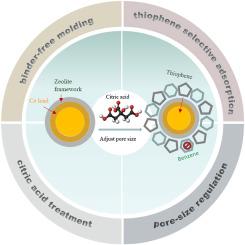同步分子筛成型和孔径调节对粗苯中噻吩的有效选择性吸附
IF 4.7
3区 材料科学
Q1 CHEMISTRY, APPLIED
引用次数: 0
摘要
使用粘合剂的成型技术对粉末材料的应用至关重要。然而,粘结剂的缠绕和堵塞通常会降低粉末材料的性能。因此,本工作研究了一种通过柠檬酸处理形成无粘结剂单体Y沸石的方法。比较了粉状沸石和整体沸石对粗苯中噻吩的选择性吸附。在所有过渡金属改性中,Ce改性对噻吩的吸附量最高,为13.5 mg g−1。成型后的吸附量达到14.9 mg g−1。在30 ~ 60℃条件下,对噻吩的吸附选择性大于84%。循环吸附三圈后,容量稳定在14.6 ~ 14.9 mg g−1之间。根据机理研究,粉状沸石和整体沸石的孔径分别集中在0.48 ~ 0.8 nm和0.6 nm。整体沸石的尺寸允许噻吩(0.53 nm)的扩散,但不允许甲苯(0.65 × 0.68 nm)的扩散,这导致了高选择性。噻吩同时被Brönsted酸性位点和Ce(OH)22+位点吸附。本工作的主要结果为沸石的成型提供了一条有用的途径。本文章由计算机程序翻译,如有差异,请以英文原文为准。

Synchronous zeolite shaping and pore-size regulation for effective selective adsorption of thiophene from crude benzene
Shaping technology using the binder is critical to the application of the powdered material. However, the binder wrapping and blockage usually decrease the performance of the powder material. This work thus investigates a method forming a binder-free monolith Y zeolite by citric-acid treatment. The powdered and monolith zeolites are compared in selective adsorption of thiophene from crude benzene. Ce modification results in the best adsorption capacity of 13.5 mg g−1 for thiophene among all transition-metal modifications. After the shaping, the adsorption capacity is even increased to 14.9 mg g−1. Moreover, its adsorption selectivity of thiophene from benzene is bigger than 84 % at 30–60 °C. In the cyclic adsorption for three turns, the capacity maintains a stable value between 14.6 and 14.9 mg g−1. According to the mechanism investigation, pore sizes of the powdered and monolith zeolites are concentrated at 0.48–0.8 nm and 0.6 nm, respectively. The size of the monolith zeolite allows diffusion in of thiophene (0.53 nm) but excludes the toluene (0.65 × 0.68 nm), which results in the high selectivity. Thiophene is both adsorbed by Brönsted acidic sites and Ce(OH)22+ sites. The main result of this work thus puts forward a useful route for the zeolite shaping.
求助全文
通过发布文献求助,成功后即可免费获取论文全文。
去求助
来源期刊

Microporous and Mesoporous Materials
化学-材料科学:综合
CiteScore
10.70
自引率
5.80%
发文量
649
审稿时长
26 days
期刊介绍:
Microporous and Mesoporous Materials covers novel and significant aspects of porous solids classified as either microporous (pore size up to 2 nm) or mesoporous (pore size 2 to 50 nm). The porosity should have a specific impact on the material properties or application. Typical examples are zeolites and zeolite-like materials, pillared materials, clathrasils and clathrates, carbon molecular sieves, ordered mesoporous materials, organic/inorganic porous hybrid materials, or porous metal oxides. Both natural and synthetic porous materials are within the scope of the journal.
Topics which are particularly of interest include:
All aspects of natural microporous and mesoporous solids
The synthesis of crystalline or amorphous porous materials
The physico-chemical characterization of microporous and mesoporous solids, especially spectroscopic and microscopic
The modification of microporous and mesoporous solids, for example by ion exchange or solid-state reactions
All topics related to diffusion of mobile species in the pores of microporous and mesoporous materials
Adsorption (and other separation techniques) using microporous or mesoporous adsorbents
Catalysis by microporous and mesoporous materials
Host/guest interactions
Theoretical chemistry and modelling of host/guest interactions
All topics related to the application of microporous and mesoporous materials in industrial catalysis, separation technology, environmental protection, electrochemistry, membranes, sensors, optical devices, etc.
 求助内容:
求助内容: 应助结果提醒方式:
应助结果提醒方式:


